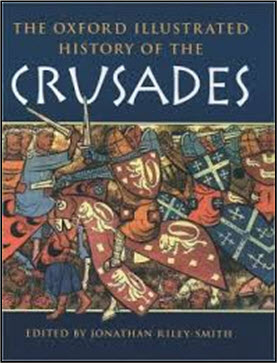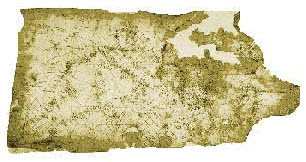


THE FINAL DEFEAT OF THE CRUSADERS 1291 and THE RESULTS (E1)
xxxxxAs we have seen (1250 H3), the campaigns launched against the Holy Land by the Mamluke Sultan Baybars, left the Christians with just a scattering of outposts. With his death in 1277, it was hoped that help would arrive, but the Council of Lyon could summon little support. European rulers were not willing to spare the cost or the time to aid a Latin State which too often lacked sound leadership and a common purpose. When the Mamlukes resumed their attacks, the fate of the Crusaders and the resident Christians was sealed. Tripoli fell in 1289 and Acre two years later in 1291. Christians who failed to escape were killed or sold into slavery. As for the Orders of Knights, the Hospitallers settled in Cyprus, the Teutonic Knights moved their operations to Eastern Europe, and the Order of Templars, accused of heresy and immorality, was stood down and later disbanded. The days of the Crusades were over.
 xxxxxWe have seen (1250 H3) what havoc was wrought against the Crusaders in the final years of the reign of the Mamluke Sultan Baybars. By 1268, after a ruthless series of campaigns against the Christians in the Holy Land, all they had left were a few defiant outposts dotted along the coast.
xxxxxWe have seen (1250 H3) what havoc was wrought against the Crusaders in the final years of the reign of the Mamluke Sultan Baybars. By 1268, after a ruthless series of campaigns against the Christians in the Holy Land, all they had left were a few defiant outposts dotted along the coast.
xxxxxWith the death of Baybars in 1277 the Crusaders hoped that there might be some respite from attack, and that some help might be on its way. In fact, there was only a little respite, and no help was on its way. There had been precious little support for the last crusade, led by Louis IX in 1270, and so when at the Council of Lyons in 1274, Pope Gregory X called for yet another military expedition, his words fell on even deafer ears. European rulers were gravely concerned with the turn of events in the Holy Land, but they were unwilling and, indeed, unable to answer the call.
xxxxxFirstly, they were very dubious about the ability of the Latin State to show a united front against the infidel and use any crusade to good purpose. The military Orders -
xxxxxWhen the Mamlukes resumed their campaign, the fate of the Crusaders and the resident Christians in the Holy Land was sealed. Tripoli fell in 1289 and Acre, the last Latin stronghold, was besieged and captured two years later in 1291, the inhabitants being put to the sword or taken into captivity. Then Acre and all the Christian fortresses along the coast were systematically destroyed. This time there was no one to come to the rescue.
xxxxxChristians who had managed to survive the holocaust fled to offshore outposts, like Cyprus, whilst the military Orders took their skills elsewhere. In 1308 the Hospitallers set up their headquarters on the island of Rhodes, and the Teutonic Knights moved their operations to the Baltic. As for the Knights Templar, they were accused of heresy and immorality -
xxxxxApart from a shameful incident in 1365, when, under the pretence of a crusade, Peter of Cyprus plundered Alexandria and massacred its inhabitants, 1291 marks the end of the crusading movement. A number of half-
xxxxxResults of the Crusades were many and varied. First and foremost, they gave an enormous boost to trade and the shipping industry, particularly in Italy and the sea-
xxxxxThere is always a danger of exaggerating the results of the Crusades, but, spread as they were over two centuries, they clearly had some important, wide-
xxxxxOne of their most enduring legacies was the boost they gave to trade, not only for the Italian cities, but also for the bustling ports and markets of the Middle East. Crusaders brought home a variety of spices, colourful textiles, and various items of hardware. These had been available earlier through other channels, of course, but never on so large a scale. There were, too, the fiscal implications. The Italian banking system was given an enormous boost and became more streamlined to meet the needs of these colossal undertakings, whilst Kings and Popes alike were obliged to introduce more efficient means of raising funds, including direct taxation. And the shipping industry also benefited from the increased demand within the Mediterranean.
 xxxxxThe military failure of all but one of these Crusades also had an effect. Not only did it undermine the authority of the Pope, but it clearly showed the disunity which existed within the Christian Church itself. National armies had often acted alone -
xxxxxThe military failure of all but one of these Crusades also had an effect. Not only did it undermine the authority of the Pope, but it clearly showed the disunity which existed within the Christian Church itself. National armies had often acted alone -
xxxxxSome joined the ranks of the Crusaders out of sheer greed, hoping to gain from the booty of war, whilst others were genuinely committed to the Christian cause or saw their involvement as an expedient means of gaining salvation. There was, too, a large number of men who went in search of new horizons, and it was this spirit of adventure, awakened in the hearts of so many men at this time, which was later to play so prominent a part in the discovery and the exploration of the New World and the lands of the East.
xxxxxThere was, too, some spin-
 xxxxxIncidentally, the increased passage of ships across the Mediterranean is likely to have accelerated the making of navigational maps for this area. It is probably no coincidence that one of the earliest surviving sea charts, hand-
xxxxxIncidentally, the increased passage of ships across the Mediterranean is likely to have accelerated the making of navigational maps for this area. It is probably no coincidence that one of the earliest surviving sea charts, hand-
xxxxxIt is certainly true that these charts -
THE RESULTS OF THE CRUSADES (E1)
E1-


